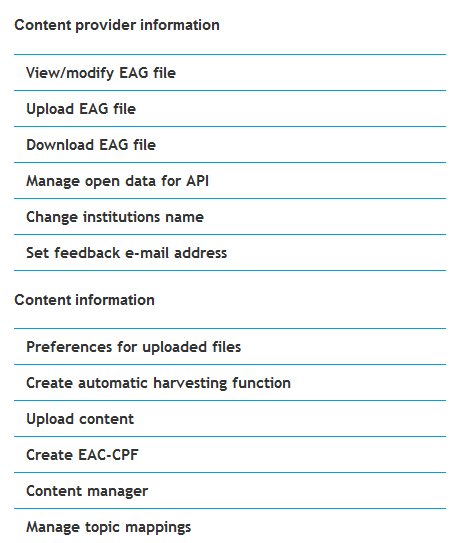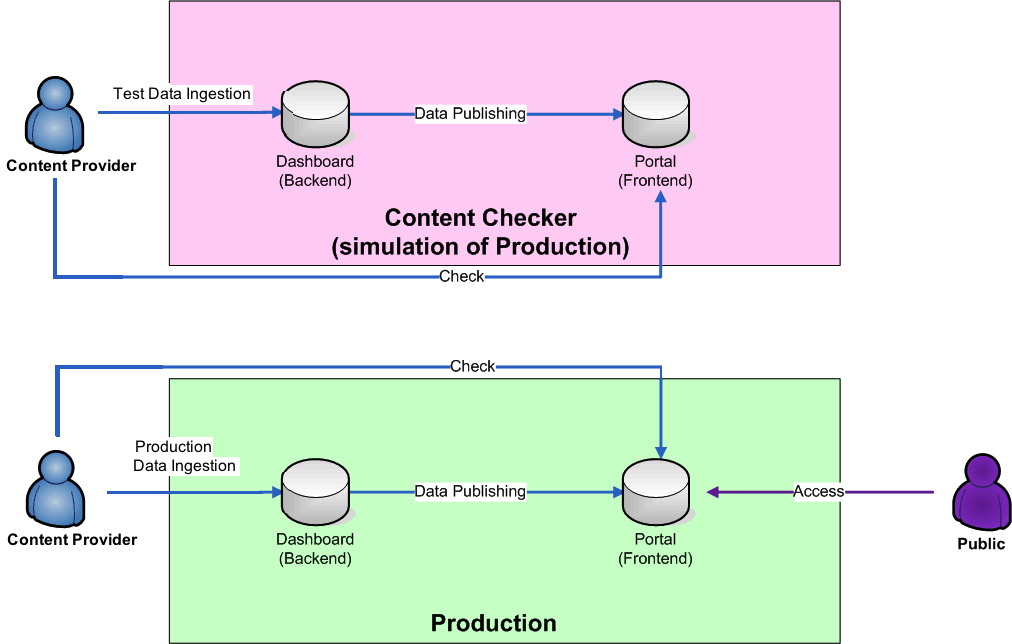Difference between revisions of "Institution Manager manual - General overview"
| Line 47: | Line 47: | ||
<!--T:13--> | <!--T:13--> | ||
| − | The Production Dashboard [https://www.archivesportaleurope.net/Dashboard http://www.archivesportaleurope.net/Dashboard] is the web environment where you upload your data for the online public production version, available for the public and the search engines. All data that is uploaded and processed here is available via the official Production Portal [http://www.archivesportaleurope.net http://www.archivesportaleurope.net]. | + | The '''Production''' Dashboard [https://www.archivesportaleurope.net/Dashboard http://www.archivesportaleurope.net/Dashboard] is the web environment where you upload your data for the online public production version, available for the public and the search engines. All data that is uploaded and processed here is available via the official Production Portal [http://www.archivesportaleurope.net http://www.archivesportaleurope.net]. |
<!--T:14--> | <!--T:14--> | ||
| − | * The Content Checker Dashboard | + | * The '''Content Checker''' Dashboard |
<!--T:15--> | <!--T:15--> | ||
Revision as of 13:47, 14 April 2016
The Archives Portal Europe publishes the archival content provided by its different partners through a back-end called the Dashboard. An option allows delivering the data also to Europeana by using the same Dashboard. These wiki pages describe the different tasks to be done by the institution manager within the Dashboard.
Administrative organisation
Three levels of administrators exist in the Dashboard: general administrator (Admin), country manager (CM), institution manager (IM).
The general administrator creates the country manager accounts within the Dashboard when asked to do so by a country and manages the CM accounts. He can take the lead on any account in case of problems.
The country manager (only one per country), generally appointed by the National archives but not always, has specific access and rights in the Dashboard, allowing him to:
- Create and organise the archival landscape of his country
- Create and suppress institutions in the archival landscape
- Give accounts to the institution’s managers
- Monitor his country (statistics etc.)
- Take the lead on an institution in case of problems
- Follow the content provider agreement (CPA) issues
The institution manager (only one per institution, but one institution manager can be in charge of different institutions) has specific access and rights in the Dashboard, allowing him to:
- upload or create and update the information on his institution (EAG form) for the directory
- upload the archival contents of his institution (EAD files and EAC-CPF files) in the portal
- manage the finding aids and EAC-CPF files in the portal: convert and validate, optionally create a holdings guide etc.
- manage the topics that populate the tag-cloud of the homepage
- convert his finding aids to EDM files and deliver them to Europeana.
Technical organisation
The Archives Portal Europe offers two environments to the partners: the Production and the Content Checker. Each environment consists of a front-end (the Portal) and a back-end (the Dashboard). They are strictly independent from each other.
- The Production Dashboard
The Production Dashboard http://www.archivesportaleurope.net/Dashboard is the web environment where you upload your data for the online public production version, available for the public and the search engines. All data that is uploaded and processed here is available via the official Production Portal http://www.archivesportaleurope.net.
- The Content Checker Dashboard
The Content Checker Dashboard https://contentchecker.archivesportaleurope.net/Dashboard is an almost exacte duplicate of the production one, meant as a simulation environment for testing purposes only. All data that is uploaded and processed here is available via it's front-end http://contentchecker.archivesportaleurope.net. This simulation or demo environment is emptied each first Tuesday of the month. The date of this so called "maintenance day" is published on the homepage of the front-end.
This simulation or demo environment allows you to experiment with the portal, to test the workflow of data upload and processing, so to check how your data will look like on the portal before publishing them "for real" in the production environment. Needless to say that it is highly recommended to use the Content Checker before using the Production Dashboard.
Principal functionalities and workflows of the Dashboard
The Dashboard includes all necessary functionalities for the Institution managers to:
- upload, validate, convert, normalise, check, create, publish content in the Archives Portal Europe,
- convert and deliver data to Europeana,
- delete contents in the Archives Portal Europe and asks for deletion in Europeana.
All source files submitted to the Archives Portal Europe should be in XML format and at least compliant with one of the following standards:
- EAD 2002 or ISAD(G) for finding aids, source guides, holdings guides;
- EAC-CPF or ISAAR-CPF for records on the persons, families or corporate bodies;
- EAG 2012 or ISDIAH for information about institutions.
It is highly recommended to use UTF-8 encoding.
The portal relies on different types of XML files: EAG files to describe the institutions, EAD files to describe the archives, EAC-CPF to describe the persons. They are all based on the archival international standards. Europeana uses another type of XML file, the EDM files. To these different types of files correspond different processes and workflows.

